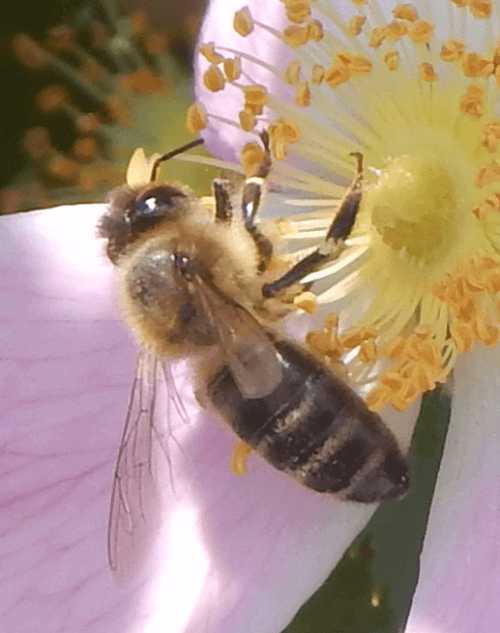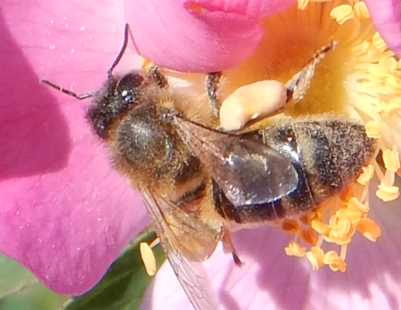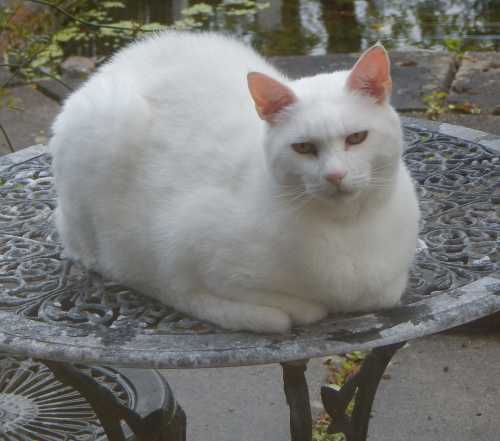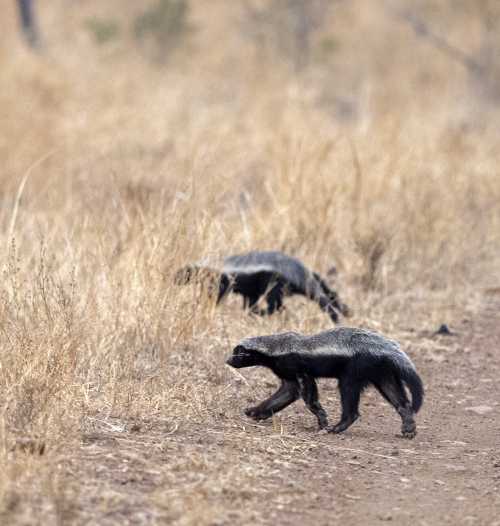Why Do Bees Make Honey?
Updated: October 2023
Question:
Why do bees make honey?
The short answer is:
Honey bees make honey
as a way of storing food to eat over the cooler winter period, when they
are unable to forage and there are fewer flowers from which to gather
food.
Honey is ideal for bees - it is full of nutrients and is a great energy food, because it is high in sugars from nectar.
When you consider that whilst flying, a honey bee's wings beat about 11,400 times per minute, it's clear they need a great deal of energy! However, flying outdoors is not the only time they beat their wings, they also do it to regulate the temperature in the hive.
Even when they are not flying out to forage for food, there is tremendous activity in the hive, and all this work requires energy.
How is honey made?
Briefly:
- Honey bees convert the sweet nectar they gather from flowers into honey.
- The nectar is stored in honeycombs.
- The
nectar they are storing starts to
concentrate (this means the water content is reduced). This process
prevents bacteria and other nasties from forming in the honeycomb,
because bacteria and fungi cannot multiply in high concentrations of
sugar, and
this is why honey rarely goes bad.
This means that honey is a form of food the bees can store and eat during the winter months, or when there is little food available.
Aah, the wisdom of honey bees!
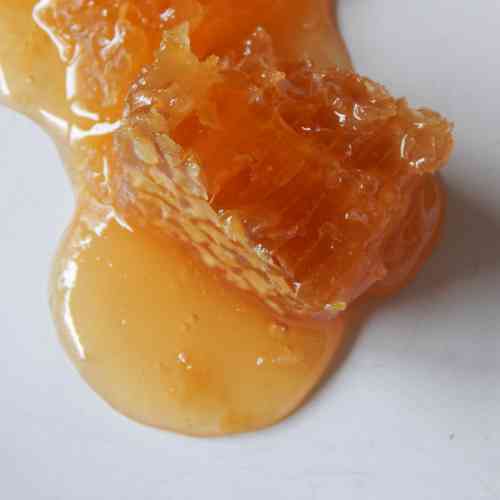 How do bees make a chunk of comb oozing honey, like this?
How do bees make a chunk of comb oozing honey, like this?You will find a very full description of this process on my page How Do Bees Make Honey? (but the question 'why?' is different!)
But for now, why not read on...
Why do bees make honey, then store it? Why don't they simply eat it as they go along?
Well
imagine this. You're stuck in your home, and the weather is so bad, that you're unable to go out and get food, and even if you
could go out for food, there wouldn't be much around anyway!
That's what it's like for honey bees in winter. Whilst they may be able to forage on a dry, cold day, it's unlikely there will be many flowers for them to forage on.
For this reason, they collect nectar when flowers are blooming, and turn it into honey which can be stored to provide them with nutrition through the winter months when there are fewer flowers.
It's a good idea to include plants and shrubs in your garden that flower early, so that honey bees will be able to feed in cold, dry weather.
Below is a photograph of a honey bee worker foraging on a winter flowering shrub called Daphne 'Jacqueline Postill'. The photograph was taken on a very cold day, and this shrub flowers from the end of January, so there were many hungry honey bees feeding on it.
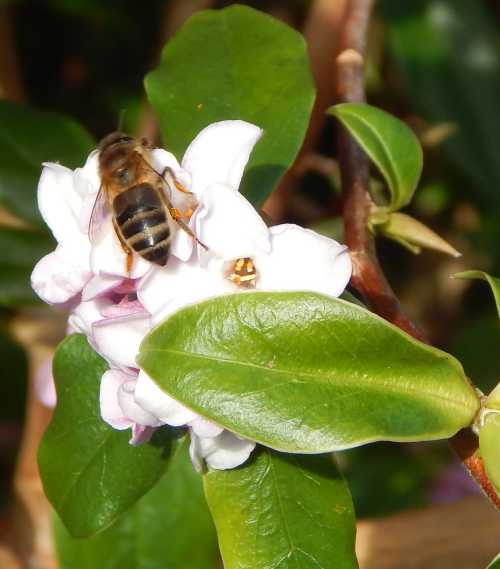
Is it alright for humans to steal the honey?
Assuming there is plenty of food available for the bees from plant and tree blossoms, and assuming the weather is okay for the honey bees to venture out, then hopefully there is plenty of honey so that it's alright for humans to take some of it.
Remember that in the wild, predation is natural. Mammals (such as the honey badger), other insects (such as wasps, hornets, and even other bees), and sometimes birds (read about the Greater Honeyguide bird) will sometimes steal some of the honey and larvae (honey bee offspring) from hives and nests!
Skilled beekeepers have a good idea about how much honey they can take without harming a colony.
What Is Honey?
There's more to honey than meets the
eye! Honey is a sugary substance made by bees using the nectar they have collected from flowers. The bees mix this with a special substance called the 'bee enzyme'.
A basic scientific formula is as follows:
A basic scientific formula is as follows:
Sucrose (nectar)
+
invertase (bee enzyme)
=
fructose + glucose (honey).
There are different presentations (set, comb honey and so on - For further information, take a look at my page: Types Of Honey) and there are also subtle differences between honeys from different bee hives, depending on where the bees have been foraging. This enables the production of different honey varieties.
Which Bees Make Honey?
Do All Bees Make Honey?
The honey you are familiar with, is made by honey bees. Bumble bees
don't make honey, instead, they have little pots of nectar. You can read more about this on my page: 'do bumble bees make honey'.
For bumble bees, it's more a case of storing nectar for a short time
period, because bumble bee colonies do not last as long as honey bee
colonies do.
Honey bee colonies have to feed a colony of workers plus the queen through the winter. With bumble bees, only the queen survives, and the rest of the colony will die.
However, there is another type of bee, referred to as the Melipona, which is a genus of stingless bees, and which makes a type of honey in small quantities, but this type of honey is not widely available.
It's always worth remembering.....
Whenever honey bees visit flowers to gather nectar with which to make honey, they pollinate flowers. Read about plant pollination.
Did you know?
Not all honey is made from nectar gathered from flowers. For example, honeydew honey is sort of made from aphid (and other bug) poop!
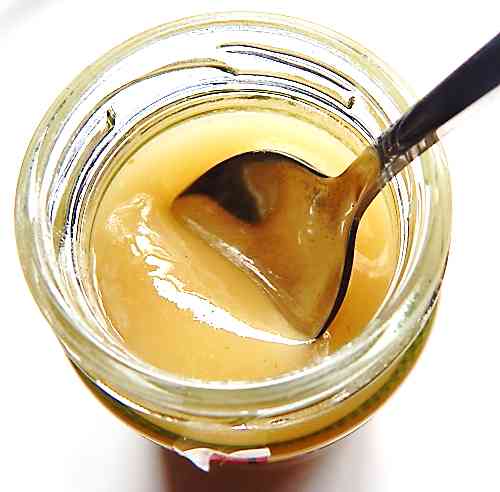 A jar of soft set honey.
A jar of soft set honey.Did you know?
Resources
- Wright GA, Nicolson SW, Shafir S. Nutritional Physiology and Ecology of Honey Bees. Annu Rev Entomol. 2018 Jan 7;63:327-344. doi: 10.1146/annurev-ento-020117-043423. Epub 2017 Oct 13. PMID: 29029590.
If you found this page helpful or interesting, I'd really be grateful if you would share it with others - if not this page, perhaps another, such as Gardening For Bees.
Thank you so much :) .
